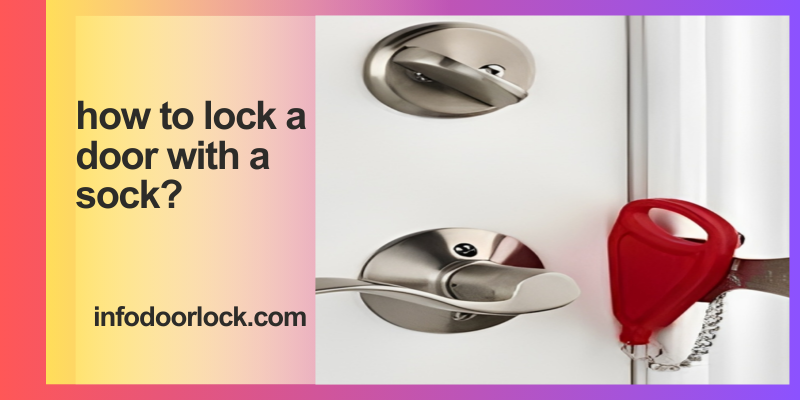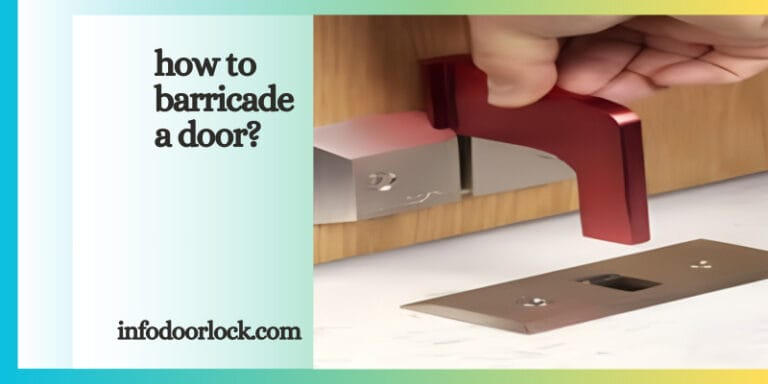How To Lock Your Door With A Sock :Easy Method (2023)
Have you ever observed yourself in a scenario in which you needed to secure a door but didn’t have a conventional lock? Whether you’re in a hostel, renting an Airbnb, or simply in search of a piece of more privateness at home, learning a way to lock a door with a sock may be an ingenious and realistic answer. This method is noticeably effective, extraordinarily easy to put into effect, and requires nothing extra than a common item you likely already have for your luggage or cloth cabinet drawer: a sock. In this short manual, we’ll show you a simple but smart way to decorate your private safety in conditions where a traditional lock isn’t always available.
To lock a door with a sock
Find a Thick Sock: Choose a strong, thick sock for higher grip and strength.
Place the Sock Over the Door Knob: Slide the sock over the door knob at the side of the door where it latches (the aspect with the lock or cope with).
Tighten and Secure: Twist the sock around the knob tightly so that the knob becomes difficult to see. If the sock is lengthy enough, you may tie a knot or tuck the end to ensure it stays in place.
Check the Door: Gently check the door to ensure the sock prevents the knob from turning without difficulty, thereby securing the door.
This technique works first-class on doors with round knobs and can provide confined safety on lever-fashion handles. Remember, this is a brief solution and ought not be relied upon for high-safety wishes.

What You Need
Locking a door with a sock is an exceptionally easy and effective approach that requires minimal substances.
A Sturdy Sock:
- Choose a sock that is thick and durable. Athletic or woolen socks are ideal, as they offer a higher grip and are much less likely to tear.
Optional: A rod or stick:
- For added security, you could use a small rod or a strong stick. This is mainly useful if the sock isn’t always thick enough or if the door is just too smooth to turn.
The splendor of this technique lies in its simplicity and the use of everyday objects, which might be without difficulty for most families or travel baggage.
Step-by-Step Guide to Locking Your Door with a Sock
Follow those steps to stabilize your door
Select the Right Sock:
- Choose a thick, strong sock. Avoid thin or tired socks, as they won’t provide enough grip.
Prepare the socks:
- If you’re using an extended sock, fold it to double its thickness. This presents extra energy and makes it tougher for the door knob to become.
Position the Sock on the door Knob:
- Slide the sock over the door knob at the facet where the door closes (the facet with the lock or take care of). Ensure it covers the knob completely.
Secure the Sock:
- Twist the sock tightly around the knob. If there’s more fabric, either tie it in a knot or tuck the result in to ensure the sock stays in place. The aim is to make the knob difficult to grip and turn.
Optional: Add a rod or stick for extra Security:
- If you have got a rod or stick, place it through the sock’s quit loop (if available) or alongside the door knob, including an additional layer of difficulty in turning the deal with.
Test the door:
- Gently test the door to make sure the sock impedes the knob from turning without difficulty. Adjust the tightness of the sock as needed.
Check from the outside:
- If possible, take a look at how stable the door is from the outside to ensure the sock offers sufficient resistance.

Tips for Ensuring Maximum Security
Use the thickest socks available
- The thicker the sock, the tougher it will be to show the knob.
Double Up:
- If one sock does not appear secure enough, recall the use of socks for added thickness.
Regular Checks:
- Periodically, take a look at the sock to ensure it hasn’t loosened through the years.
Be mindful of the door type:
- This technique works best with round knobs. Lever handles might also require additional securing techniques.
Remember, while this approach can provide a transient solution for privacy or a sense of protection, it isn’t always a foolproof method and ought not be totally relied upon for safety in excessive-threat conditions. This technique is fine when used along with other security measures whenever possible.
Benefits of Using a Sock to Lock Your Door
Using a sock to lock a door offers numerous blessings, making it a popular desire for temporary door protection:
Ease of Use:
- Anybody can use this method, regardless of experience with do-it-yourself projects or home security, as it is quite simple.
Cost-Effectiveness:
- Socks are not unusual household items, so there’s no need to spend money on additional devices. This makes it a price range-friendly option as compared to buying unique locks or security gadgets.
Portability:
- A sock is light-weight and easy to carry, making it a super solution for vacationers, students, or anyone on the move.
No Damage to Doors:
- Unlike some different temporary locking strategies, the use of a sock doesn’t make the door or door deal with it.
Ideal for various situations:
- It’s in particular useful in transient dwelling situations like hotels, dorm rooms, or rented accommodations wherein you may not have permission to install everlasting locks.

Safety Considerations
While a sock can provide a primary stage of safety, it’s essential to apprehend its boundaries:
Temporary Solution:
- This method has to only be visible to a brief degree for privacy or to discourage informal intruders.
Not a Replacement for Traditional Locks:
- It’s no longer as steady as a traditional lock and should no longer be used as a sole safety measure in high-threat situations.
Use Judiciously:
- Employ this technique in conditions in which better privateness is needed, in preference to for lengthy-term security.
Have an exit Strategy:
- Always ensure you can effortlessly remove the sock from the internal in case of an emergency where a short exit is essential.
Alternative Methods for Temporary Door Security
Apart from the use of a sock, there are other strategies to steady a door without a traditional lock:
Using a chair:
- Placing a chair below the door can prevent the door from establishing itself. This is powerful for doors that open inward.
Using a Belt:
- You can loop a belt around the door and a heavy, immovable object around it to limit the manager’s motion.
Portable Travel Locks:
- These are particularly designed gadgets that can be quickly established on maximum doors to provide additional safety.
Door Wedge or Stopper:
- An easy door wedge may be used to save the door from being opened from the outside.
Comparison with the Sock Method
Effectiveness:
- While the sock technique is useful for knobs, different methods like transportable locks or door wedges may provide more safety.
Convenience:
- The sock technique ranks excessively on convenience, as socks are more effortlessly available than precise equipment like journey locks.
Suitability:
- The preferred method depends on the kind of door and the extent of security desired. For instance, a chair works well for inward-commencing doors, just as a sock is flexible for distinctive knob types.

Conclusion : How To Lock Your Door With A Sock
The method of using a sock to lock a door is a simple yet imaginative solution for temporary door protection. It sticks out for its ease of use, fee-effectiveness, and portability, making it a handy option for travelers, students, or absolutely everyone in a temporary living scenario. This approach is particularly beneficial when traditional locks are not to be had or when you want an extra layer of privacy. While it’s important to consider that that is a temporary measure and no longer a complete-fledged protection answer, the sock method can offer peace of mind in many ordinary situations.
We’ve protected the basic necessities, a step-with the aid of-step guide, the benefits, protection issues, and even alternative strategies for securing a door. Each alternative has its own personal merits, and the selection in large part depends on the precise situations and the extent of protection wanted. The sock approach, with its time-honored availability and ease of implementation, emerges as an especially on hand and realistic choice for on-the-pass safety.
Call to Action
We want to listen to you right now! Has anyone ever attempted to lock a door using a sock? Do you have any extra suggestions or opportunity strategies that you have determined are powerful? Please proportion your reviews and insights within the comments below. Your contribution can be a precious resource for others seeking easy protection solutions.
Additionally, if you’re interested in more sensible suggestions and lifestyle hacks like this, consider signing up for our newsletter or following us on social media. We regularly provide beneficial, clean-to-put into effect ideas that could make your daily life more handy and stable. Join our network and stay updated with ultra-modern tricks and hints!
FAQs: How To Your Door With A Sock
How do you operate a sock lock?
- To use a sock as a lock, first discover a robust sock, preferably thick for higher grip. Slide the sock over the door knob on the side on which the door closes. Twist the sock tightly around the knob, and if it is long enough, tie a knot or tuck the cease to ensure it remains in vicinity. This method makes the knob hard to turn, thereby securing the door.
How do you lock a door with an item?
- To lock a door with an item, you could use normal gadgets like a chair, belt, or wedge. For example, place a chair under the door handle to save it from being opened (for inward-commencing doorways) or loop a belt across the door to cope with a heavy, immovable object. A door wedge can be used to jam the door from the bottom, preventing it from being opened from the outside.
How can I stable a door without a lock?
- To secure a door without a lock, you may use diverse strategies:
Sock Lock:
- Use a thick sock to make the door knob hard to turn.
Chair Method:
- Place a chair under the door.
Belt Technique:
- Loop a belt across the door handle and an immovable item.
Door Wedge/Stopper:
- Use a wedge to jam the door from the bottom.
Portable Travel Locks:
- These gadgets may be briefly installed on doors for added safety.
What is a lock in a sock known as?
- A lock in a sock, frequently called a “sock lock,” is a makeshift locking mechanism in which a sock is used to restrict the motion of a door knob, making it difficult to turn and open the door. It’s an easy, DIY technique for temporary door security using a common family object.
What is a lock sock?
- A lock sock is a colloquial term for a selfmade safety device in which a sock is used to secure a door knob. The sock is twisted across the knob.








One Comment